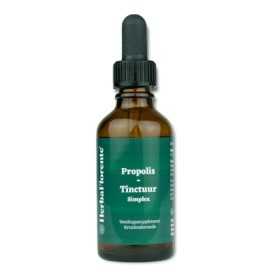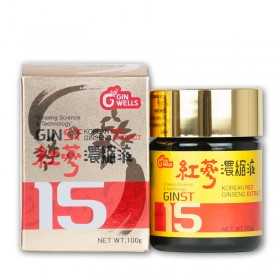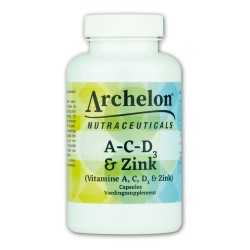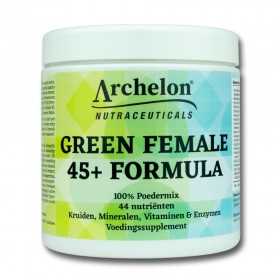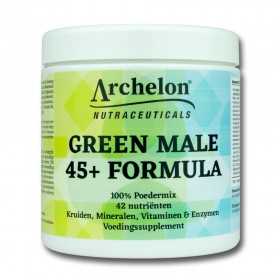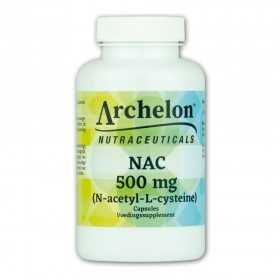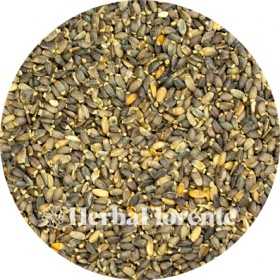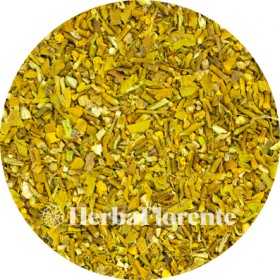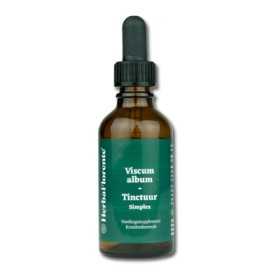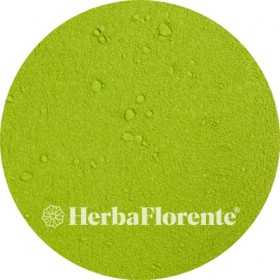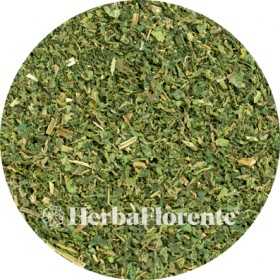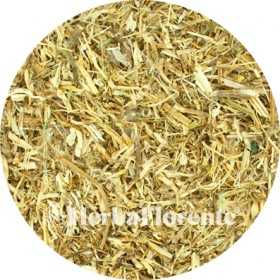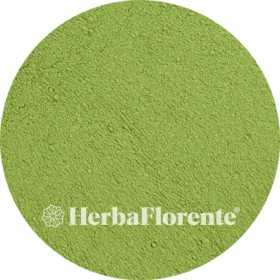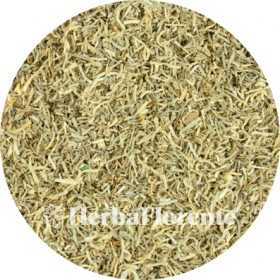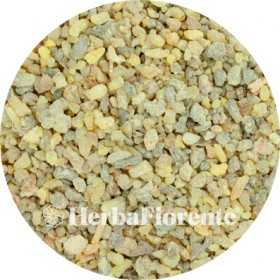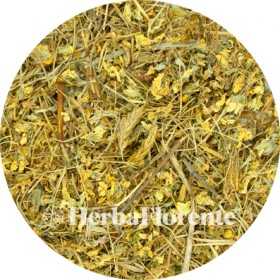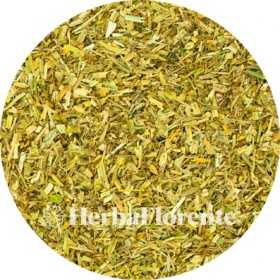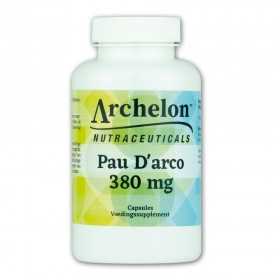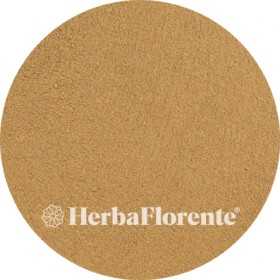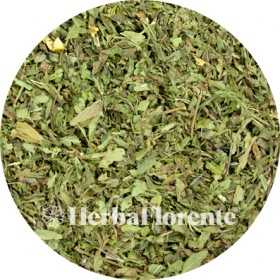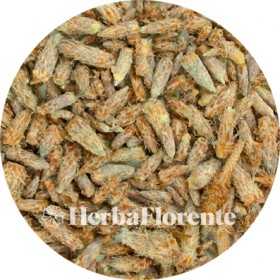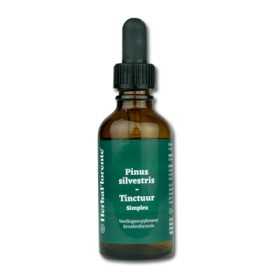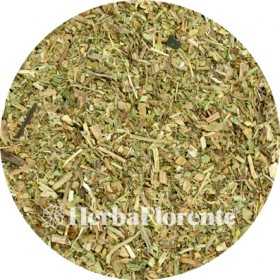Resistance
There are 227 products.
Milk Thistle (Seed) - Sylibum marianum, Cardui Mariae - Whole
Milk thistle (Silybum marianum), also known as milk thistle or milk thistle, is a spiny plant native to the Mediterranean region, but which also grows in our area. It belongs to the composite family. Milk thistle has been used for centuries as a natural remedy to support liver and bile function. It can be used as part of a cleansing regimen to assist the liver in the detoxification process.
The seeds of milk thistle contain silymarin, a powerful antioxidant. Silymarin stimulates the liver in the natural detoxification process and thus supports liver function.
The seeds of milk thistle contain silymarin, a powerful antioxidant. Silymarin stimulates the liver in the natural detoxification process and thus supports liver function.
€2.00
From: €2.00
Mistletoe - Viscum alba
Mistletoe (Viscum album) is an evergreen plant belonging to the sandalwood family, known by various names such as mistletoe, mistletoe, or birdlime. Mistletoe naturally occurs in Europe, Northwest Africa, West and Central Asia. It is a semi-parasite that thrives in the wild on numerous host species.
Over the centuries, mistletoe has become intertwined with numerous legends and symbolic meanings. To the Druids, the mistletoe of an oak tree was sacred and associated with ushering in the new year, symbolic of fertility and good luck. In Norse mythology, mistletoe symbolizes peace and love, with people who meet under it kissing each other as a sign of this peace and love.
Over the centuries, mistletoe has become intertwined with numerous legends and symbolic meanings. To the Druids, the mistletoe of an oak tree was sacred and associated with ushering in the new year, symbolic of fertility and good luck. In Norse mythology, mistletoe symbolizes peace and love, with people who meet under it kissing each other as a sign of this peace and love.
€2.00
From: €2.00
Mistletoe Tincture - Viscum album Tincture
Single herbal tincture made with dried herb of Viscum album (Mistletoe).
Mistletoe (Viscum album) is an evergreen plant belonging to the sandalwood family, known by various names such as mistletoe, mistletoe, or birdlime. Mistletoe naturally occurs in Europe, Northwest Africa, West and Central Asia. It is a semi-parasite that thrives in the wild on numerous host species.
Mistletoe (Viscum album) is an evergreen plant belonging to the sandalwood family, known by various names such as mistletoe, mistletoe, or birdlime. Mistletoe naturally occurs in Europe, Northwest Africa, West and Central Asia. It is a semi-parasite that thrives in the wild on numerous host species.
€9.95
Moringa Tree - Moringa oleifera (Leaf Grounded)
Moringa oleifera, also known as the 'tree of life', thrives in Africa and Asia and is known for its rich nutritional value. The tree is a treasure trove of more than dozens of nutrients, including no fewer than 47 antioxidants. Containing minerals, proteins, vitamins, beta-carotene, amino acids and various phenols in abundance, the leaves of the moringa are the true storehouse of nutritional value.
For centuries, Asian and African cultures have recognized the benefits of moringa oleifera. The tree has become an integral part of their daily diet due to its versatile uses and nutritional value. Because of its abundant benefits, moringa oleifera is often affectionately referred to as "the tree of life."
For centuries, Asian and African cultures have recognized the benefits of moringa oleifera. The tree has become an integral part of their daily diet due to its versatile uses and nutritional value. Because of its abundant benefits, moringa oleifera is often affectionately referred to as "the tree of life."
€3.20
From: €3.20
Mullein - Verbascum thapsus
The mullein (Verbascum thapsus) is a member of the marram family (Scrophulariaceae) and mainly thrives in dune and chalk areas, where it is quite common. This plant is rare to find elsewhere in the Netherlands.
The flowers of the mullein are yellow and have a diameter of 1.5–3 cm. They consist of five connate petals, five sepals and five stamens, three of which are covered with yellow or white hairs. The flowers grow in dense spikes and bloom from July to autumn. An adult plant can reach a height of more than two meters.
The flowers of the mullein are yellow and have a diameter of 1.5–3 cm. They consist of five connate petals, five sepals and five stamens, three of which are covered with yellow or white hairs. The flowers grow in dense spikes and bloom from July to autumn. An adult plant can reach a height of more than two meters.
€5.00
From: €5.00
NAC (N-Acetyl-L-Cysteine) - 500 mg
N-acetyl-cysteine (NAC) is a form of the sulfur-containing semi-essential amino acid L-cysteine. It is found in dairy, meat, fruit and vegetables, but this is often insufficient and can best be supplemented through supplementation. The advantage that N-acetyl-cysteine has over cysteine is that it is better and more easily absorbed by our body. Furthermore, N-acetyl-cysteine supports production of the important tripeptide glutathione in our body. Glutathione plays a role in protecting our cells against oxidative stress.
€24.95
Nettle (Herb) - Urticae dioica
The nettle (Urtica dioica) is a powerful and versatile plant that occurs in many places, despite its irritating property to the touch. Known for its culinary uses, such as nettle soup and tea, the nettle is also known for its health benefits.
Nettle leaf is a traditional herbal medicine with various applications. It contributes to healthy skin, gives shine to the hair and strengthens the nails. In addition, it can help soothe the respiratory tract and maintain proper fluid balance. It also provides support to the heart and blood vessels.
Nettle leaf is a traditional herbal medicine with various applications. It contributes to healthy skin, gives shine to the hair and strengthens the nails. In addition, it can help soothe the respiratory tract and maintain proper fluid balance. It also provides support to the heart and blood vessels.
€2.00
From: €2.00
Nettle (Root) - Urticae dioica
Nettle (Urtica dioica) is a powerful and versatile plant that can be used in many ways. Although the plant stings when touched, it is best known for its valuable properties. Nettle is not only loved in the kitchen (think of nettle soup or tea), but also because of its many benefits for humans.
This wild plant, native to Africa and Asia and known by the Latin name Urtica dioica, has been used for centuries. In herbal medicine, not only the dried leaves, but also the dried roots are valued. Nettle root is used to support good prostate function.
This wild plant, native to Africa and Asia and known by the Latin name Urtica dioica, has been used for centuries. In herbal medicine, not only the dried leaves, but also the dried roots are valued. Nettle root is used to support good prostate function.
€2.20
From: €2.20
Nettle - 380 mg
The nettle (Urtica dioica) is a powerful and versatile plant that occurs in many places, despite its irritating property to the touch. Known for its culinary uses, such as nettle soup and tea, the nettle is also known for its health benefits.
Originally from Africa and Asia, the plant goes by the Latin name Urtica dioica and has been used for centuries. In herbalism, not only the dried leaves, but also the dried roots are used.
Nettle leaf is a traditional herbal medicine with various applications. It contributes to healthy skin, gives shine to the hair and strengthens the nails. In addition, it can help soothe the respiratory tract and maintain proper fluid balance. It also provides support to the heart and blood vessels.
Originally from Africa and Asia, the plant goes by the Latin name Urtica dioica and has been used for centuries. In herbalism, not only the dried leaves, but also the dried roots are used.
Nettle leaf is a traditional herbal medicine with various applications. It contributes to healthy skin, gives shine to the hair and strengthens the nails. In addition, it can help soothe the respiratory tract and maintain proper fluid balance. It also provides support to the heart and blood vessels.
€17.95
Nettle - Urticae dioica
The nettle (Urtica dioica) is a powerful and versatile plant that occurs in many places, despite its irritating property to the touch. Known for its culinary uses, such as nettle soup and tea, the nettle is also known for its health benefits.
Nettle leaf is a traditional herbal medicine with various applications. It contributes to healthy skin, gives shine to the hair and strengthens the nails. In addition, it can help soothe the respiratory tract and maintain proper fluid balance. It also provides support to the heart and blood vessels.
Nettle leaf is a traditional herbal medicine with various applications. It contributes to healthy skin, gives shine to the hair and strengthens the nails. In addition, it can help soothe the respiratory tract and maintain proper fluid balance. It also provides support to the heart and blood vessels.
€2.40
From: €2.40
Old Men's Beard - Usnea barbata
Usnea barbata, sometimes also called 'old man's beard', is a genus of lichens belonging to the ascomycetes. They are found in moist forests around the world, where they usually hang from tree branches. In rare cases they are also found on the bottom or on rocks. The genus belongs to the family of Parmeliaceae. Beard mosses are characterized by a shrub-like structure and a central axis from which branches arise. In areas free of air pollution they can grow 10 to 20 cm tall.
€5.50
From: €5.50
Olibanum Idian - Boswelia serrata
Olibanum Idian (Boswellia serrata) is a medium to large deciduous tree with a slightly open crown and branches that hang slightly. This tree belongs to the Burseraceae family and is native to India and the Punjab area.
Olibanum Idian is extracted from the resin of the tree. Extracts of Boswellia serrata have been clinically studied for osteoarthritis and joint pain, showing a slight improvement in pain and function. In traditional Ayurveda it is used for diabetes.
Boswellia serrata produces several forms of boswellic acids, such as β-boswellic acid, acetyl-β-boswellic acid, 11-keto-β-boswellic acid and acetyl-11-keto-β-boswellic acid.
Olibanum Idian is extracted from the resin of the tree. Extracts of Boswellia serrata have been clinically studied for osteoarthritis and joint pain, showing a slight improvement in pain and function. In traditional Ayurveda it is used for diabetes.
Boswellia serrata produces several forms of boswellic acids, such as β-boswellic acid, acetyl-β-boswellic acid, 11-keto-β-boswellic acid and acetyl-11-keto-β-boswellic acid.
€2.60
From: €2.60
Olive - Olea europaea
Olive leaves, from the wild olive tree (Olea europaea), are naturally rich in antioxidants. Originally native to western Asia, Egypt and Syria, these trees are now a distinctive sight throughout the Mediterranean region, as well as in regions such as South America, the southern United States, southern Australia and the tropics. Olive leaf tea has been consumed in the Mediterranean for centuries, and this is not surprising given the known antioxidant properties of olive leaves. It is therefore no coincidence that the olive tree is often referred to as the 'tree of life'.
€2.25
From: €2.25
Pansy, Herb trinit (Flower) - Viola tricolor
Out-of-Stock
The pansy (Viola tricolor) belongs to the violet family (Violaceae) and is native to Europe, from Lapland to the Mediterranean, and even in Siberia.
This plant, which is an annual but can sometimes be perennial, grows to a height of 30 cm and has roots that can go up to 45 cm deep. The flowering period extends from May to October. The flowers are at least 1 cm wide, but usually larger, with an average diameter of 1.5 cm.
The pansy was first described as a medicinal herb by Rembert Dodoens in 1554. It was traditionally used for childhood diseases and respiratory diseases. In England it was popular for treating heart disease, chest cramps and pleurisy
This plant, which is an annual but can sometimes be perennial, grows to a height of 30 cm and has roots that can go up to 45 cm deep. The flowering period extends from May to October. The flowers are at least 1 cm wide, but usually larger, with an average diameter of 1.5 cm.
The pansy was first described as a medicinal herb by Rembert Dodoens in 1554. It was traditionally used for childhood diseases and respiratory diseases. In England it was popular for treating heart disease, chest cramps and pleurisy
€7.00
From: €7.00
Pansy, Herb trinit Herb - Viola tricolor - Cut
The pansy (Viola tricolor) belongs to the violet family (Violaceae) and is native to Europe, from Lapland to the Mediterranean, and even in Siberia.
This plant, which is an annual but can sometimes be perennial, grows to a height of 30 cm and has roots that can go up to 45 cm deep. The flowering period extends from May to October. The flowers are at least 1 cm wide, but usually larger, with an average diameter of 1.5 cm.
The pansy was first described as a medicinal herb by Rembert Dodoens in 1554. It was traditionally used for childhood diseases and respiratory diseases. In England it was popular for treating heart disease, chest cramps and pleurisy
This plant, which is an annual but can sometimes be perennial, grows to a height of 30 cm and has roots that can go up to 45 cm deep. The flowering period extends from May to October. The flowers are at least 1 cm wide, but usually larger, with an average diameter of 1.5 cm.
The pansy was first described as a medicinal herb by Rembert Dodoens in 1554. It was traditionally used for childhood diseases and respiratory diseases. In England it was popular for treating heart disease, chest cramps and pleurisy
€2.00
From: €2.00
Pau D'arco - 380 mg
Pau d'arco (Tabebuia avellanedae) is an imposing tree that thrives in the Amazon rainforest. The bark of the pau d'arco has been used for centuries in traditional herbal medicine for its diverse uses, including its supportive effects on the immune system.
The inner layer of the bark of Tabebuia avellanedae is packed with flavonoids, powerful antioxidants that protect our bodies against oxidative damage caused by free radicals. In addition, it contains a significant amount of quinones. More than 20 quinone compounds have already been discovered in the bark of the pau d'arco, such as lapachol and beta-lapachone. In addition, the bark contains substances that help defend against unfavorable bacteria and fungi.
The inner layer of the bark of Tabebuia avellanedae is packed with flavonoids, powerful antioxidants that protect our bodies against oxidative damage caused by free radicals. In addition, it contains a significant amount of quinones. More than 20 quinone compounds have already been discovered in the bark of the pau d'arco, such as lapachol and beta-lapachone. In addition, the bark contains substances that help defend against unfavorable bacteria and fungi.
€19.95
Pau D'arco - Tabeuiae
Pau d'arco (Tabebuia avellanedae) is an imposing tree that thrives in the Amazon rainforest. The bark of the pau d'arco has been used for centuries in traditional herbal medicine for its diverse uses, including its supportive effects on the immune system.
The inner layer of the bark of Tabebuia avellanedae is packed with flavonoids, powerful antioxidants that protect our bodies against oxidative damage caused by free radicals. In addition, it contains a significant amount of quinones. More than 20 quinone compounds have already been discovered in the bark of the pau d'arco, such as lapachol and beta-lapachone. In addition, the bark contains substances that help defend against unfavorable bacteria and fungi.
The inner layer of the bark of Tabebuia avellanedae is packed with flavonoids, powerful antioxidants that protect our bodies against oxidative damage caused by free radicals. In addition, it contains a significant amount of quinones. More than 20 quinone compounds have already been discovered in the bark of the pau d'arco, such as lapachol and beta-lapachone. In addition, the bark contains substances that help defend against unfavorable bacteria and fungi.
€2.60
From: €2.60
Peppermint - Menthae piperita
Peppermint oil (Mentha piperita) is often taken to support digestion. Peppermint is a member of the Lamiaceae family and is used for making peppermint candy.
In herbal medicine, peppermint has a long history dating back to ancient Greece. There, the fragrant peppermint leaf was traditionally used to aid digestion. Peppermint contains several essential oils, including menthol, menthone and cineole.
Peppermint originated from a cross between water mint (Mentha aquatica) and spike mint (Mentha spicata). In the seventeenth century, this plant was discovered in England in a field with mint plants.
In herbal medicine, peppermint has a long history dating back to ancient Greece. There, the fragrant peppermint leaf was traditionally used to aid digestion. Peppermint contains several essential oils, including menthol, menthone and cineole.
Peppermint originated from a cross between water mint (Mentha aquatica) and spike mint (Mentha spicata). In the seventeenth century, this plant was discovered in England in a field with mint plants.
€2.00
From: €2.00
Pine (Needles) - Pinus silvestris
The Scots pine (Pinus sylvestris) belongs to the pine family (Pinaceae) and can reach a respectable age of 200 to 300 years, thanks to its rich resin content.
In phytotherapy, the needles and buds of the Scots pine are used because of their content of tannins, flavonoids and vitamins. The oleoresin of this tree is rich in turpentine. This species is known for its abundant monoterpenes, such as α-pinene, β-pinene and limonene, which form an essential oil with expectorant, antiseptic, decongestant, venolymphatic and anti-inflammatory properties.
In phytotherapy, the needles and buds of the Scots pine are used because of their content of tannins, flavonoids and vitamins. The oleoresin of this tree is rich in turpentine. This species is known for its abundant monoterpenes, such as α-pinene, β-pinene and limonene, which form an essential oil with expectorant, antiseptic, decongestant, venolymphatic and anti-inflammatory properties.
€2.00
From: €2.00
Pine (Seedlings) - Pinus silvestris
The Scots pine (Pinus sylvestris) belongs to the pine family (Pinaceae) and can reach a respectable age of 200 to 300 years, thanks to its rich resin content.
In phytotherapy, the needles and buds of the Scots pine are used because of their content of tannins, flavonoids and vitamins. The oleoresin of this tree is rich in turpentine. This species is known for its abundant monoterpenes, such as α-pinene, β-pinene and limonene, which form an essential oil with expectorant, antiseptic, decongestant, venolymphatic and anti-inflammatory properties.
In phytotherapy, the needles and buds of the Scots pine are used because of their content of tannins, flavonoids and vitamins. The oleoresin of this tree is rich in turpentine. This species is known for its abundant monoterpenes, such as α-pinene, β-pinene and limonene, which form an essential oil with expectorant, antiseptic, decongestant, venolymphatic and anti-inflammatory properties.
€2.80
From: €2.80
Pine Tincture - Pinus silvestris Tincture
Single herbal tincture made with dried needle of Pinus silvestris (Pine).
The Scots pine (Pinus sylvestris) belongs to the pine family (Pinaceae) and can reach a respectable age of 200 to 300 years, thanks to its rich resin content.
In phytotherapy, the needles and buds of the Scots pine are used because of their content of tannins, flavonoids and vitamins. The oleoresin of this tree is rich in turpentine. This species is known for its abundant monoterpenes, such as α-pinene, β-pinene and limonene, which form an essential oil with expectorant, antiseptic, decongestant, venolymphatic and anti-inflammatory properties.
The Scots pine (Pinus sylvestris) belongs to the pine family (Pinaceae) and can reach a respectable age of 200 to 300 years, thanks to its rich resin content.
In phytotherapy, the needles and buds of the Scots pine are used because of their content of tannins, flavonoids and vitamins. The oleoresin of this tree is rich in turpentine. This species is known for its abundant monoterpenes, such as α-pinene, β-pinene and limonene, which form an essential oil with expectorant, antiseptic, decongestant, venolymphatic and anti-inflammatory properties.
€9.95
Plantain Broadleaf - Plantaginis major
The Plantain Broadleaf (Plantago major) is a plant belonging to the plantain family (Plantaginaceae) and varies in size from 10 to 50 cm. It forms a dense leaf rosette that is resistant to foot traffic, which is why it is often considered a weed. This plant species is common in gardens, along roads and paths, and is sometimes derisively called the "white man's footprint". Nevertheless, there is a cultivated variety known as Plantago major 'Rosularis'.
€2.00
From: €2.00
Power Berries+ Formula
Our Power Berries+ Formula provides a balanced blend of nutrients specially formulated to support your overall health. This unique formula is packed with healthy fiber and essential nutrients, including polyphenols, phytonutrients, antioxidants and natural vitamins.
€57.50
Power Veggies+ Formula
Our Power Veggies+ Formula provides a balanced blend of essential nutrients to support your overall health. With an abundance of healthy fibers and nutrients, is Power Veggies+ Formula specially formulated to nourish and glow your body.
€59.50

